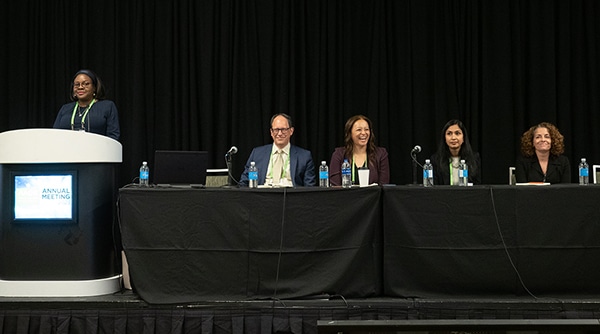Annual Meeting 2023: Boosting Diversity in Clinical Trials (Part 1, Trial Design)
An individual with hypertension visits their primary care physician and learns that two new medications for their condition have just been approved. One drug was tested in a population in which only 1% of participants identified as Black. The other drug was tested in a cohort in which 15% of participants identified as Black.
According to a study performed by the National Bureau of Economic Research, Black patients were 20% more likely to choose the drug tested in a more diverse patient population, while white patients had no preference. Similarly, physicians caring for Black patients were significantly more likely to recommend the drug tested in the diverse cohort than the other drug.
“In our survey, 72 percent of physicians reported that they have been asked by patients whether a new medicine will ‘work in people like me,’” the study stated, underscoring the impact that clinical trial design can have on a patient’s trust in a therapy. A diverse study population can also help researchers study the side effects and treatment-related biomarkers in patients of different backgrounds, as explained in the 2022 AACR Cancer Disparities Progress Report.
At the AACR Annual Meeting 2023, held April 14-19, experts in cancer health disparities discussed effective approaches for recruiting diverse patients into clinical trials. In this two-part blog series, we will highlight the challenges and solutions presented during four sessions on the topic.
Addressing Enrollment Barriers
In a session titled “Challenges in Clinical Trial Enrollment,” experts addressed barriers that prevent underserved individuals from enrolling in clinical trials and provided potential solutions.
Muhammad Shalaan Beg, MD, MBA, vice president of oncology at Science 37, focused on the lack of geographical access for many Americans. He argued in favor of decentralizing clinical trials, or adapting them so they can be performed chiefly from home.
Decentralization requires the careful restructuring of processes to promote the standardization of sample collection, treatment, and monitoring procedures. This may necessitate clinical trial investigators with licensures in multiple states seeing patients via telemedicine, a mail-order delivery system for study drugs, and/or mobile nurses deployed to collect samples in remote locations.
“When you have all these processes together, you have the formation of a clinical trial site itself—a meta-site,” Beg said.
Socioeconomic factors can also adversely affect clinical trial enrollment, according to Chanita Hughes-Halbert, PhD, a professor of population and public health sciences and the vice chair for research in preventive medicine at the Keck School of Medicine and the associate director for cancer equity at the University of Southern California.
In one study, Hughes-Halbert and her colleagues found that prostate cancer survivors living in areas with a high social deprivation index were 30% less likely to enroll in a study about social determinants of health and 42% less likely to activate their patient portal, a common means of communication about clinical trial opportunities.
Basic and clinical research have indicated that social isolation and chronic stress, both common among individuals with high social deprivation, may increase cancer aggressiveness and patient mortality rates. In an ongoing study, Hughes-Halbert and colleagues are studying the biological and behavioral mechanisms that underlie this link via a stress reactivity test and a survey.
Hughes-Halbert explained how her team overcame a significant challenge of recruitment: “By having the standard, generic invitation letter that described the purpose of the study and the procedures involved, no one responded,” she explained. “We developed a one-page flyer that had information about me and information about why this study was so important for addressing the needs of African American women. The 110 women we enrolled were a result of that effort.”
Underrepresented patients are also deterred from joining clinical trials by cultural and language barriers, explained Maria Elena Martinez, PhD, a professor in the department of Family and Preventative Medicine at the University of California, San Diego (UCSD) Moores Cancer Center.
In 2016, the UCSD Clinical Trials Office launched a community outreach and engagement partnership that included focus groups with team leaders, clinical trials staff, and patients. These conversations revealed that limited information about clinical trial opportunities and the physician’s lack of language and cultural competency posed significant challenges.
To address these hurdles, UCSD increased the number of consent forms translated into Spanish, hired more ethnically diverse and bilingual providers and patient navigators, and mandated cultural competency training for clinical trials staff. Between 2013 and 2019, the proportion of Hispanic patients enrolled in clinical trials at UCSD increased from 16% to 21%.
Katherine Panageas, DrPH, an attending biostatistician and director of research support at Memorial Sloan Kettering Cancer Center, emphasized the responsibility of institutions to consider diversity early in the process of designing a clinical trial.
In 2022, the U.S. Food and Drug Administration (FDA) issued a draft guidance on Diversity Plans to Improve Enrollment of Participants from Underrepresented Racial and Ethnic Populations in Clinical Trials, in which they encouraged drug developers to submit a diversity action plan accompanying every clinical trial. The guidance became a law in December 2022, making diversity action plans mandatory for all phase III studies. Drug developers are now required to describe target enrollment for various populations and mechanisms for recruiting and retaining said populations in the trial.
For researchers seeking advice on implementing a diversity action plan, Panageas suggested partnering with community centers and patient advocacy groups to foster engagement in target communities, adapting clinical trial designs to minimize physical and geographical barriers, and allowing for changes to the trial protocol as additional data become available.
Implementing Diversity Action Plans
Last fall, the AACR organized a roundtable workshop with government stakeholders and industry leaders to facilitate the exchange of concerns and ideas about diversity action plans. At the Annual Meeting, a panel of roundtable participants discussed key considerations for developing and implementing diversity action plans.
“Sharing of information is so critical to moving forward on this topic,” said session cochair Lola Fashoyin-Aje, MD, MPH, associate director of the Science & Policy Program to Address Disparities within the Oncology Center of Excellence of the FDA. “There’s a lot to be learned by all of us, and there’s a lot that’s going to evolve over time as our understanding and experience evolve.”

Craig Tendler, MD, vice president of oncology clinical development and global medical affairs at Janssen Research & Development, LLC, began by emphasizing the shift in institutional culture necessary to ensure the success of diversity initiatives.
“We would never start a trial without having a fully comprehensive clinical development program,” Tendler said. “If we’re going to be successful in our diversity and inclusion efforts, we need to integrate that same level of commitment and comprehensive planning.”
An ideal plan would consider the strategies, risks, and potential obstacles to the recruitment of diverse populations before the trial begins, Tendler explained. He placed the responsibility on drug development companies to normalize early planning via governance and institutional support.
Bea Lavery, MSc, vice president of regulatory affairs at Genentech, stressed that thinking ahead should include implementing diversity plans into early-phase clinical trials. She suggested that some unnecessarily strict exclusion criteria used in phase I and II trials to ensure that the safety and dosing of a drug are tested in a controlled, relatively homogeneous population could hinder progress in phase III.
“You want the patient population you enroll in these pivotal trials to be the same population that will be using the drugs,” Fashoyin-Aje added. She stressed that determining the effects of a drug in patients with various comorbidities is part of ensuring the safety for all patients. “The goal should not be, ‘let me design the perfect trial, then decide if I can include these people in the trial,’” she said.

Chitkala Kalidas, PhD, vice president and global head of oncology regulatory affairs and oncology sustainability at Bayer, stressed that eligibility criteria and other components of a diversity action plan should not only be discussed once, but should be systematically reevaluated during the study.
“It’s no different to me than coming up with a statistical analysis plan initially and revising it as the program progresses,” Kalidas said.
Study sites are another component of the diversity plan that should be carefully selected and regularly evaluated, Kalidas said, adding that partnering with community hospitals to serve target demographics requires an investment in long-term relationships.
Sandra Amaro, MBA, head of clinical trial diversity at Pfizer, elaborated, explaining that relationship building should begin long before patients are needed for a trial, and that it should address patients’ needs beyond those related to a study. Ideally, such relationships should involve education and trust building. “We’re getting those patients ready, so that if and when they need a clinical trial, they know what a clinical trial is, and they know to have a voice for themselves to ask for the clinical trial,” Amaro said.
Amaro succinctly summarized her thoughts on community and site engagement, as well as the session as a whole: “If you don’t have a plan, your goals are just a wish.”
For more information on community engagement as it pertains to increasing diversity in clinical trials, stay tuned for part two of this post, which will cover a forum discussion on the topic, as well as a symposium held by leaders of the AACR Minorities in Cancer Research council.


